Yoga is a sport that involves physical poses, concentration, and deep breathing, which has been practiced since ancient times. Today, yoga is known as a popular form of exercise all over the world. Yoga has many health benefits, such as improving flexibility, balance, strength, metabolism and mental health. Yoga can also overcome various problems that many people often experience, such as stress, depression, pain and inflammation.
Benefits of Yoga for Beginners
With every controlled movement and breath, yoga opens the door to extraordinary benefits. In this SVRG article, we will explore in more depth how yoga can increase body flexibility, reduce stress, improve balance, and provide strength and stamina. Plus, we'll look at how yoga can be the key to improving sleep, creating a solid foundation for beginners to start their journey towards holistic health and wellness. Welcome to the world of yoga, where every movement is a step towards a more balanced and calm life.
-
Body Flexibility
Yoga movements are designed to engage the body's various muscle groups, helping to increase flexibility. By performing asanas that involve stretching and bending, beginners will notice an increase in the elasticity of their muscles. This stretch helps reduce muscle stiffness and expands the body's range of motion, allowing a person to move more freely and comfortably in daily activities. -
Reduces Stress and Anxiety
Yoga not only focuses on the physical aspect, but also on the state of mind. The meditation practices integrated in yoga help create self-awareness and focus attention on the present moment. Controlled breathing and focused movement help calm the nervous system, reduce stress hormone levels, and overcome anxiety. This creates a calm and stable mental space for beginners. -
Improved Balance and Coordination
Yoga asanas, especially those involving positions that require stability, such as standing on one leg or a plank position, help improve balance and coordination. This exercise stimulates the use of core muscles and strengthens the body structure, building a strong foundation for developing overall body balance. Increased body awareness also supports improved coordination between body and mind. -
Increases Strength and Stamina
Yoga involves a series of movements that require the use of one's own body weight as a load. Asanas like Chaturanga Dandasana or Warrior Poses target major muscles and help build strength. Therefore, consistently engaging in yoga practices can help improve overall body strength. Apart from that, breathing exercises in yoga can also increase stamina, allowing the body to remain active and energetic for longer. -
Improve Sleep Quality
Beginners who engage in regular yoga practices may notice improved sleep quality. Calming movement and meditation before bed helps relax the mind and body, reducing tension you may have experienced throughout the day. Increased self-awareness and controlled breathing can also help overcome insomnia, creating a more peaceful and comfortable sleep environment.
Also read: Is Yoga Really for Weight Loss? Here's the answer
Yoga Movements for Beginners
Yoga has different types of poses based on how the body moves to complete them. However, there are several yoga movements that are suitable for beginners, because they are not too difficult and do not require special equipment, just having a yoga mat is enough. Here are 5 yoga movements for beginners that you can try at home, along with how to do them and their benefits:
1. Mountain Pose (Tadasana)
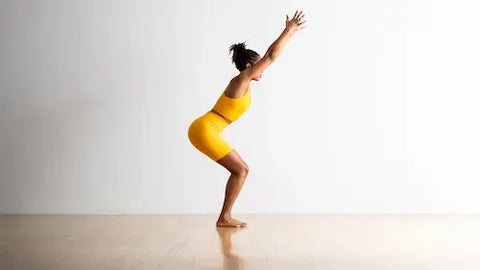
Mountain pose is the basic movement for all standing poses. This movement helps improve posture and strengthens the legs and stomach.
How to do it:
- Stand with your feet hip-width apart, hold your breath for five to eight seconds, then exhale slowly, and maintain this pose.
- Pull your shoulders back and down, lift your chest, and pull your stomach in.
- Extend your arms to the sides or up, and relax your neck and face.
Benefits:
- Improves body alignment and balance.
- Tightens the muscles of the legs, stomach and back.
- Opens chest and shoulders.
- Calms the mind and breathing.
2. Chair Pose (Utkatasana)
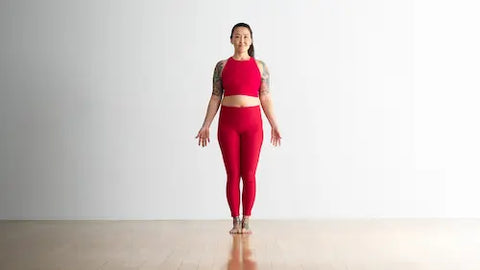
Chair pose is a movement that trains the muscles of the lower and middle body. This movement helps shape and strengthen the muscles of the thighs, calves, buttocks, stomach and back.
How to do it:
- From mountain pose, raise your arms up, and bend your knees as if sitting on a chair.
- Keep your knees not past your toes, and press your heels into the floor.
- Pull your shoulders back and down, lift your chest, and pull your stomach in.
- Hold this pose for a few breaths, then return to mountain pose.
Benefits:
- Burn calories and body fat.
- Strengthens the muscles of the thighs, calves, buttocks, stomach and back.
- Improves blood circulation and metabolism.
- Improves heart and lung health.
Also read: Turns Out It's Easy! Here's How to Clean a Yoga Mat
3. Down Dog on a Chair (Ardha Adho Mukha Svanasana)
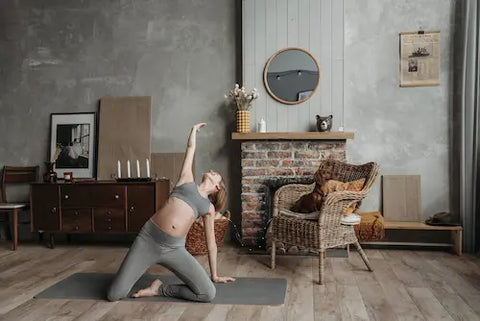
Down dog on a chair or downward facing dog on a chair is a movement that is a modification of downward-facing dog. This movement helps stretch and relax the muscles of the upper and lower body.
How to do it:
- Get a sturdy, stable chair and place it in front of you.
- Stand behind a chair, and hold the edge of the chair with both hands.
- Step back until your body forms a 90 degree angle with the floor.
- Bend your knees slightly, and press firmly into your hands and feet.
- Make sure to keep your body straight, pull your stomach in, and straighten your back.
- Hold this pose for a few breaths, then return to a standing position.
Benefits:
- Stretches and relaxes the muscles of the arms, back, hips and legs.
- Increases body flexibility and balance.
- Increases blood and oxygen circulation to the brain.
- Reduces stress and anxiety.
4. Downward-Facing Dog (Adho Mukha Svanasana)
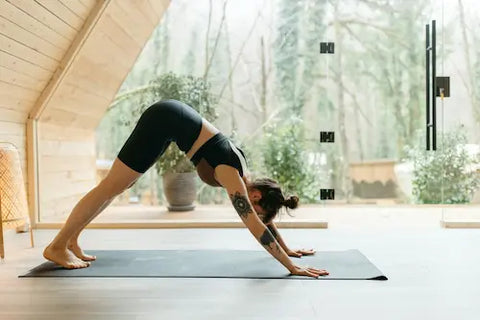
Downward-facing dog is a movement that trains the muscles of the upper and lower body. This movement helps improve blood circulation, strengthens the muscles of the arms, back and legs, and opens up the chest and shoulders.
How to do it:
- Start on all fours on the floor, with your knees under your hips, and your hands under your shoulders.
- Keep your back straight, and take a deep breath.
- As you exhale, fold your toes and lift your knees.
- Move your sitting bones toward the ceiling, and lengthen your tailbone from the back of your pelvis.
- Bend your knees slightly, and press firmly into your hands and feet.
- Make sure to keep your body straight, pull your stomach in, and straighten your back.
- Keep your legs parallel, and hold this position for one to three minutes.
Benefits:
- Increases blood and oxygen circulation to the brain.
- Strengthens the muscles of the arms, back and legs.
- Opens chest and shoulders.
- Stretches and relaxes the muscles of the hips, thighs, calves and heels.
5. Warrior II (Virabhadrasana II)
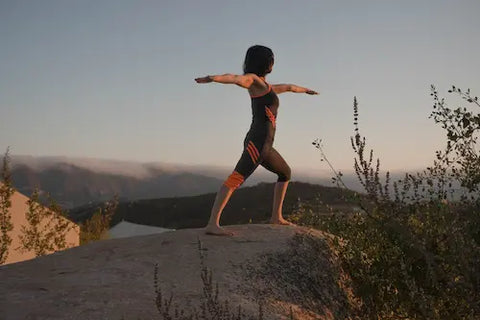
Warrior II or second warrior is a movement that trains the muscles of the lower and middle body. This movement helps shape and strengthen the muscles of the thighs, calves, buttocks, stomach and back, as well as improving balance and concentration.
How to do it:
- From mountain pose, step to the side with your right foot about one meter, and turn your right foot forward.
- Bend your right knee until it forms a 90 degree angle, and make sure your knee does not go past your toes.
- Keep your left leg straight, and turn your left foot slightly inward.
- Raise your arms to the sides until they are parallel to the floor, and look towards your right hand.
- Pull your shoulders back and down, lift your chest, and pull your stomach in.
- Hold this pose for a few breaths, then repeat with the other leg.
Benefits:
- Burn calories and body fat.
- Strengthens the muscles of the thighs, calves, buttocks, stomach and back.
- Improves balance and concentration.
- Increase self-confidence and self-confidence.
In understanding and carrying out yoga movements for beginners, we weave a story of harmony between body, mind and soul. Every step, every pose, brings us closer to ourselves and a more balanced life.
Moments spent in asana, in conscious breathing, teach us the meaning of true presence. When we stretch our bodies, we also stretch our boundaries. When we seek tranquility through meditation, we find that silence is a source of strength.
As a beginner, every effort is a success, every breath is a step towards better health. Let's keep exploring, keep learning, and keep appreciating the beauty of this journey. Yoga movements for beginners are not only about physical flexibility, but also about flexibility in accepting yourself, with all its advantages and disadvantages.















